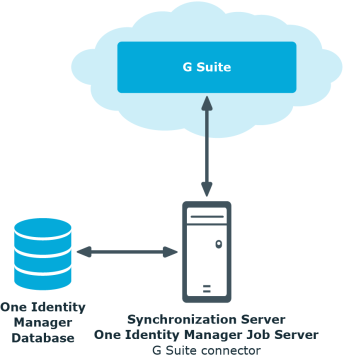Mapping G Suite in One Identity Manager
Mapping G Suite in One Identity Manager
One Identity Manager offers simplified user administration for G Suite. One Identity Manager concentrates on setting up and editing user accounts and providing the required permissions. For this, groups, organizations, permissions, admin roles, products, and SKUs are mapped in One Identity Manager.
One Identity Manager provides company employees with the user accounts required to allow you to use different mechanisms for connecting employees to their user accounts. You can also manage user accounts independently of employees and therefore set up administrator user accounts.
For more detailed information about the G Suite structure, see the G Suite documentation from Google.
Architecture overview
To access G Suite data, the G Suite connector is installed on a synchronization server. The G Suite connector establishes communication with the G Suite to be synchronized through several Google Inc. REST APIs. The synchronization server ensures data is compared between the One Identity Manager database and G Suite.
Figure 1: Architecture for synchronization

One Identity Manager users for managing G Suite
The following users are used for setting up and administration of G Suite
Table 1: Users
|
Target system administrators |
Target system administrators must be assigned to the Target systems | Administrators application role.
Users with this application role:
-
Administer application roles for individual target system types.
-
Specify the target system manager.
-
Set up other application roles for target system managers if required.
-
Specify which application roles for target system managers are mutually exclusive.
-
Authorize other employees to be target system administrators.
-
Do not assume any administrative tasks within the target system. |
|
Target system managers |
Target system managers must be assigned to the Target systems | G Suite application role or a child application role.
Users with this application role:
-
Assume administrative tasks for the target system.
-
Create, change, or delete target system objects like user accounts or groups.
-
Edit password policies for the target system.
-
Prepare entitlements to add to the IT Shop.
-
Can add employees who have an other identity than the Primary identity.
-
Configure synchronization in the Synchronization Editor and define the mapping for comparing target systems and One Identity Manager.
-
Edit the synchronization's target system types and outstanding objects.
-
Authorize other employees within their area of responsibility as target system managers and create child application roles if required. |
|
One Identity Manager administrators |
-
Create customized permissions groups for application roles for role-based login to administration tools in the Designer as required.
-
Create system users and permissions groups for non role-based login to administration tools in the Designer as required.
-
Enable or disable additional configuration parameters in the Designer as required.
-
Create custom processes in the Designer as required.
-
Create and configure schedules as required.
-
Create and configure password policies as required. |
Configuration parameter
Use configuration parameters to configure the behavior of the system's basic settings. One Identity Manager provides default settings for different configuration parameters. Check the configuration parameters and modify them as necessary to suit your requirements.
Configuration parameters are defined in the One Identity Manager modules. Each One Identity Manager module can also install configuration parameters. In the Designer, you can find an overview of all configuration parameters in the Base data | General | Configuration parameters category.
For more information, see Configuration parameters for managing G Suite.

